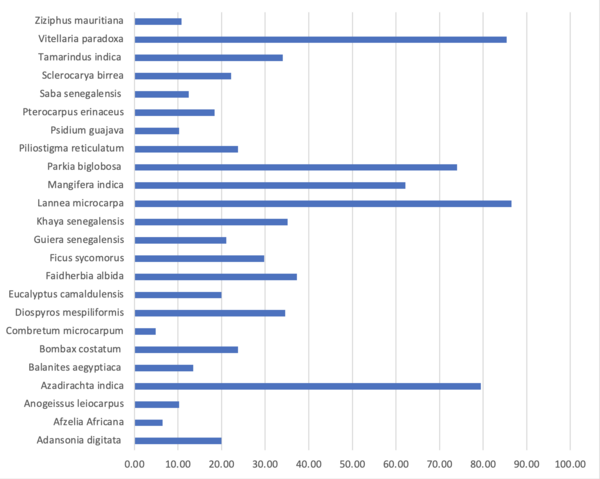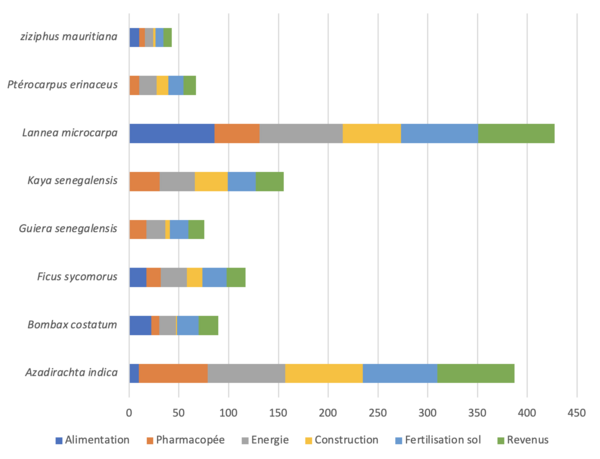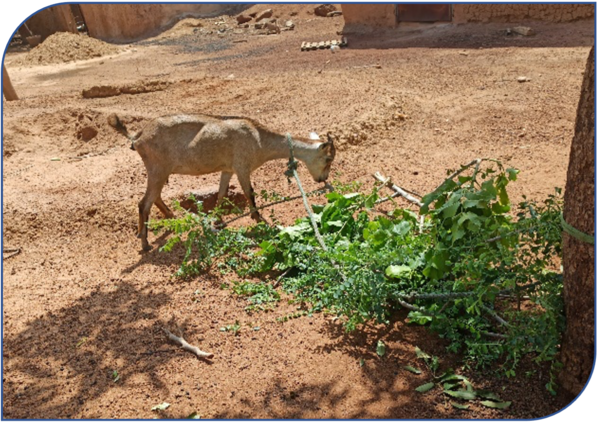Livestock farming is important in Burkina Faso, however, feeding is a major constraint. During the dry season, fodder resources are scarce and producers have difficulty covering the needs of their herds (Kiema et al., 2012; Sanon 2020). Protein-rich woody plants help to maintain the animals during this period. Although they are numerous, not all species are consumed by ruminants. In addition to these aspects, woody plants contribute to human well-being through the provision of various services (Boffa, 2000; Sib, 2018).
Within the SustainSahel project, an ethnobotanical survey was conducted in order to understand the locally available woody plants, the local uses for the plants andto identify the most palatable woody plants for small ruminants, according to the herders. A semi-open questionnaire was administered to 185 households from 6 villages in the Centre-West of Burkina Faso, Villy, Saria, Tampelega, Yargo Yarcé, Ramonkodogo, and Poa.
Result from the study
From this study, 47 woody plants were identified among the population, of which 23 were cited by more than 5% of the respondents (see Figure 1). The respondents recognise the use of woody plants in several use categories, including: food, pharmacopoeia (human and animal), soil fertilisation, firewood and construction wood. The sale of wood and non-wood forest products is also a significant source of income for the surveyed populations.
Finally, fodder trees are highly palatable to ruminants. A total of 15 fodder plants divided into 10 families and 15 genera were mentioned as being highly palatable to small ruminants. The frequency of citation made it possible to classify the ligneous plants and to select the eight most cited by the farmers. These are:
- Ficus sycomorus (41.08%),
- Lannea microcarpa (38.92%),
- Pterocarpus erinaceus (32.92%),
- Khaya senegalensis (22.70%),
- Azadirachta indica (21.08%),
- Bombax costatum (9.73%),
- Guiera senegalensis (9.19%),
- Ziziphus mauritiana (5.95%).
These woody plants, which are the most popular with sheep, are also used for other purposes by the population (see Figure 2). Thus, there is a strong anthropic pressure on these woody species which could negatively impact the survival of these species as highlighted by Dossou et al. (2012) and Ouattara et al. (2021).
In view of the importance of fodder trees for humans and animals, an awareness-raising campaign on the harvesting, maintenance and mass planting of interesting trees is urgently needed for sustainable natural resource management.
Written by: PhD student, Traore Linda Cletchio Gabriella, Natural Science and Agronomy, option animal production systems at UNB - Nazi Boni University in Burkina.
Further information
Cited literature
Boffa J-M. 2000. Les parcs agroforestiers en Afrique de l’Ouest : clés de la conservation et d’une gestion durable. 51, 11-17. ISBN 92-5-2043-76
Sib O. 2018. Co-conception d’un système fourrager innovant : introduction des banques fourragères arbustives dans les élevages laitiers de l’Ouest du Burkina Faso. Thèse de doctorat, Alimentation et nutrition. Systèmes de production animale, Université Nazi Boni, 185 p.. Https://agritrop.cirad.fr/596595
Sanon, H O, Zorma A, Simian A, Obulbiga F M, Compaoré E. 2020. Analyse des pratiques d’embouche ovine dans deux zones semi-arides du Burkina Faso. Journal of Applied Biosciences, 150, 15390–15402. DOI: doi.org/10.35759/JABs.150.1
Dossou M E, Houessou G L, Lougbégnon O T, Tenté A H B, Codjia J T C. 2012 Etude ethnobotanique des ressources forestières ligneuses de la forêt marécageuse d’Agonvè et terroirs connexes au Bénin. Tropicultura, 30 (1), 41-48. DOI: www.researchgate.net/publication/259558319
Ouattara B, Sanou L, Koala J, Hien M. 2021. Utilisations locales et vulnérabilité des espèces ligneuses dans les forêts classées de Oualou et de Tissé au Burkina Faso, Afrique de l’Ouest. Afrique SCIENCE , 19(3) 63-77 ISSN 1813-548X. DOI: 6.pdf (afriquescience.net)






 tap and then scroll down to the Add to Home Screen command.
tap and then scroll down to the Add to Home Screen command.